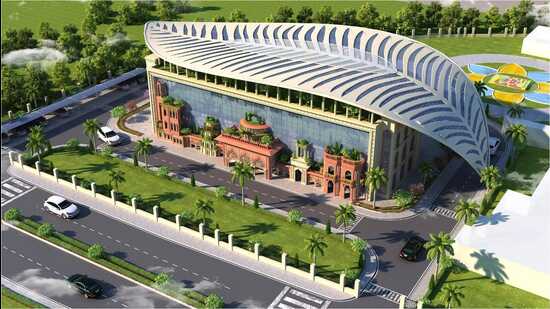Fossils of interest: Rarest of rare collections on display at BSIP museum soon
The museum will be spread over 5000 sq ft of which 2100 sq feet will be dedicated to a herbarium. This will be the first time in BSIP that a herbarium will be set up in the institute. This herbarium will include 30,000 herbarium sheets, 4,000 fruits and seeds, 4313 wood slides, 12,000 Palynological slides, 3,000 palm anatomy slides and 4,000 wood blocks.
Lucknow: For people interested in learning about the origin of the Earth and evolution of human life, the new museum and herbarium at Birbal Sahni Institute of Palaeosciences (BSIP) will be a one-stop destination soon.

“The institution has a large collection of artefacts in its repositories. From the oldest cyanobacteria fossil of a stromatolite from the Aravalli ranges dating back to over 2.7 billion years to some human and animal bones which are about 2000 years old, several rare artefacts will be exhibited in the new museum,” said director, BSIP Mahesh Thakkar.
The building of the museum will be completed within the next four months but the completion of the museum will take another one to one-and-a-half years, according to Thakkar. The museum is spread over 5000 sq ft of which 2100 sq feet will be dedicated to the herbarium. This will be the first time in BSIP that a herbarium will be set up in the institute. This herbarium will include 30,000 herbarium sheets, 4,000 fruits and seeds, 4313 wood slides, 12,000 Palynological slides, 3,000 palm anatomy slides and 4,000 wood blocks.
Among other unique and rare artefacts that will be displayed in the museum are Hiroshi Hara sheets which were collected by Japanese scientist Hiroshi Hara from the eastern Himalayas in the 1950s.
“These slides are so rare that several taxonomists across the world visit the institution to see them every year,” said Gaurav Srivastava, a scientist and also a member of the museum committee .
A stalagmite of Meghalayan age dating back to over 4,200 years, which is the only type specimen of the age in India, will also be displayed. Other exhibits include pollen of extinct and endangered plants, ancestral varieties of plants like bamboo, mango, coconut, eucalyptus, Indian bay leaf, Arjun and sweet potato which are also rare, acording to Srivastava.
Some plant specimens of the biodiversity areas in eastern Himalayas, Andaman and Nicobar Islands, Western Ghats and Indo-Myanmar range will also be among the exhibits in the museum.
“Other important artefacts include Amber (fossilized tree resin) -embedded specimens of ants, spiders, beetles, termites and some plant and insect species. There are 10,000 such specimens which are part of the repository. These date back to about 5.5 crore years,” shared another scientist and convenor of the Museum committee, Hukam Singh.
Scientist and member of museum committee Shilpa Pandey said that the herbarium would house a Birbal Sahni Room dedicated to the founder of the institution and palaeobotanist Birbal Sahni.
“The artefacts and instruments used by Sahni will be displayed in the room. We are trying to incorporate his AI-based sculpture which will provide in-depth knowledge about his life. As an extension of the museum, we will have a mobile learning centre which will be in the form of a bus providing details about the origin and evolution of earth, life and human beings through short films, documentaries, 3D models and replicas of microfossils. The scientists will also stage street plays as part of the mobile learning centre,” shared Pandey.
ARTEFACTS TO BE EXHIBITED
Oldest cyanobacteria fossil of a stromatolite about 2.7 billion years old
- Hiroshi Hara sheets collected by Japanese scientist Hiroshi Hara of the Eastern Himalayan region
- Only type specimen of Meghalayan Age about 4200 years old
- Pollen of extinct and endangered plants
- Some plant specimens of biodiversity areas
- Amber (fossilized tree resin) embedded specimens of insect species.





